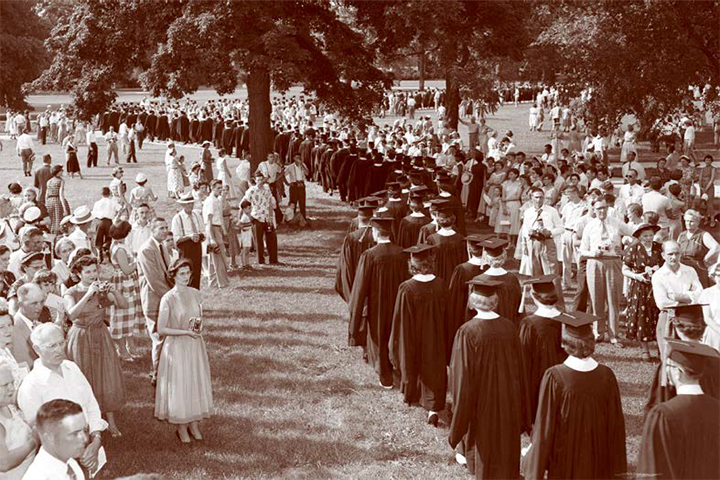Every May the campus community comes together at commencement to recognize the hard work, dedication, and achievement of another graduating class. While the reason for celebration has remained the same over time, the ceremony itself has changed as the University has evolved.
The class of 1860.
In the early years, the ceremony wasn’t full of the pomp and circumstance expected today. Caps and gowns, for example, were considered inappropriate and impractical. The first commencement on June 29, 1860, was consequently a modest affair. The 10 graduates shared their scholarly papers before board members presented diplomas. Graduates, faculty, and guests then gathered for a meal.
As the University grew and more students graduated, a second ceremony was needed. A morning and evening session was held by 1881 to enable all students to read their papers—despite graduates’ attempts to abandon the practice. Activities expanded to encompass a week of events including senior and junior class plays, receptions, dances, and picnics. With commencement often serving as a homecoming, alumni gatherings and receptions were held throughout the week as well.
Commencement became more like the ceremony of today in 1934, when President Raymond Fairchild instituted academic regalia. It too has changed over the years. In 1980, the University designated red and white tassels for undergraduates, gold for master’s degree students, and black tassels for doctoral recipients. Graduates today don biodegradable black gowns featuring the University seal.
The processional was added by Fairchild as well. Graduates marched through Old Main to Sherwood Forest, which is the area where the Center for Performing Arts now stands. The ceremony was held in an outdoor amphitheater in June, with another ceremony for the College of Education held in August before classes began.
In later years, the event expanded again and moved to Braden Auditorium, Capen Auditorium, Horton Field House, and Redbird Arena. Various locations were needed because the University recognized graduates within their individual colleges, creating six ceremonies. A December commencement was added in 1991. Both traditions continue today, ensuring that all graduates have the memorable moment of crossing the commencement stage.
COMMENCEMENT: FIRSTS AND FACTS
1860: The first commencement was held in the new Old Main building on campus. Ten students participated and presented their papers.
1881: The University instituted a second evening ceremony to accommodate the rising numbers of graduates.
1916: Student-read papers were abandoned in favor of a main commencement speaker, much to the delight of graduates.
1934: For the first time, graduates and faculty wore caps and gowns, adding a professional and ceremonial feeling to the event. It was also the first year for an outdoor ceremony.
1968: The president’s medallion was worn during the ceremony for the first time. Samuel Braden started the tradition.
1980: The tassels of graduates’ caps took on three distinct patterns: red and white for undergraduates, gold for master’s degrees, and black for doctoral graduates.
1990: Commencement ceremonies cost $14,000.
1991: The first December commencement was held in Redbird Arena.
1993: A second December ceremony was added due to increased numbers of graduates.
2012: The May commencement ceremonies celebrated the accomplishments of approximately 3,400 graduates across six colleges.

